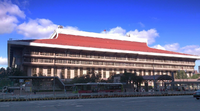Monsilvan Railways Administration
| Monsilvan Railways Administration | |||
|---|---|---|---|
| Overview | |||
| Native name | 山國鐵路 | ||
| Locale | |||
| Transit type | Heavy rail | ||
| Number of lines | 34 | ||
| Number of stations | 145 (+200 under state-only administration) | ||
| Annual ridership | 231,267,955 (2018) | ||
| Chief executive | Paub Buapo | ||
| Website | railway.gov.ms | ||
| Operation | |||
| Began operation | 1938 | ||
| Operator(s) | Monsilvan Railways Administration | ||
| Character | Mixed | ||
| Number of vehicles | 900 | ||
| Technical | |||
| Track gauge | 1,435 mm (4 ft 8+1⁄2 in) | ||
| Top speed | 300 km/h (190 mph) | ||
| |||
The Monsilvan Railways Administration (MRA) (Monsilvan: 山國鐵路) is a railway operator in Monsilva. It is an agency of the Department for Transport, responsible for managing, maintaining, and running conventional passenger and freight railway services on throughout Monsilva. It is owned entirely by the federal government and runs all rail transportation between Monsilva's states.
Since Monsilva is heavily urbanised, railways have played an important part in domestic transportation since the late 19th century. Passenger traffic in 2018 was 231,267,955. The MRA administers all railways in Monsilva, however state level railway operators can run services on their tracks. Examples include the Amking Metro which sprawls all across Amking and uses a lot of MRA rail.
The agency's headquarters are in Fangu, Amking.
Contents
Overview
Shānguó Tiělù | |
 | |
 Amking Central Station west entrance, from which the MRA headquarters can be accessed. | |
| Agency overview | |
|---|---|
| Formed | 1938 |
| Jurisdiction | |
| Headquarters | Fangu, Amking |
| Minister responsible |
|
| Agency executive |
|
| Parent department | Federal government of Monsilva |
| Website | railway.gov.ms |
Railway services between Amking and Shangrao began in 1891 under the Kingdom of Monsilva. Monsilva's railway network saw significant development throughout the 1930s and 40s under the premiership of Heng Lei. Before 1938, most of Monsilva's railway was used for freight transport for goods. The Monsilvan Railways Administration was established on 5 March 1938 to reconstruct and operate railway infrastructure, with passenger rail services becoming the main priority in order to handle Monsilva's growing population and economy.
The MRA is a government organisation that falls under Monsilva's Department for Transport (MDOT) and employs around 13,500 people (4,700 in transportation and 7,700 in maintenance titles). The MRA's railway system is divided into 6 operating companies (Monsilvan: 列車運營公司) which have specific juristiction over a specific number of the total 34 lines.
Since the early 1980s, conventional railway capital improvements are nationally funded and managed by the MDOT's Railway Reconstruction Bureau, then turned over to MRA for operations. Monsilva's constantly varying terrain causes the network to feature many tunnels, bridges and crossings. In 1990, the M¥75.4 billion (₵12.5 billion) standard gauge high-speed rail (HSR) line was built and is operated by the MRA's High Speed Railway Company, which is one of the MRA's six total operating companies. It runs services between Amking and many major cities in Monsilva.
Local and intercity passenger services (5am – 2am, very few overnight trains) operate at 89.9% on-time performance. 2008 annual passenger ridership was 210 million (incurring 5.45 billion passenger-miles), generating M¥3.62 billion in revenue. Commuter trains carry 76% of riders (43% of passenger miles). Other long-distance trains such as high-speed carry around 20% of riders (30% of passenger miles). In many parts of Monsilva, natural disasters can occur, especially in the wetter months. Trains are engineered to avoid accidents via emergency braking and anti-flood systems during earthquakes and typhoons respectively.
In years past, an extensive shipper-owned light railway network (non-TRA operated) handled freight services throughout Monsilva and boasted a large amount of Monsilva's railway. Largely abandoned today, it served important industries including sugar, logging, coal, salt, and minerals. Its tracks have since been reused by local metropolitan railways and newer freight services.
Staffing costs, pension benefits, capital debt, changing demographics, highway competition, and low fare policies resulted in accumulated deficits nearing US$3.3 billion. Although viewed locally as a serious issue, especially among more conservative senators and members of the Chamber, they are negligible in comparison to other deficits faced by the government via other departments with the Department for Transport being one of the largest grossing departments in the federal government.
In the 1970s and 80s, growth in the highway system and increased competition from bus companies and airlines led to a decline in long-distance rail travel, though short and intermediate distance travel was still heavily utilized by commuters and students. This allowed the MRA to keep a foothold on transport until the 90s after the highspeed rail line was built, leading to a massive increase in rail travel and a significant decline in highway transport. TRA also puts a large emphasis on tourism and short-distance commuter service. This has led to several special tourist trains running to scenic areas and hot springs, the addition of dining cars and intentionally slower paced trains, and converting several smaller branch lines to attract tourists.
